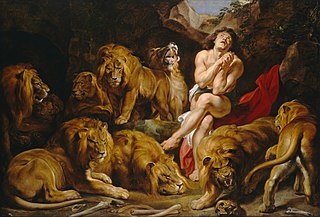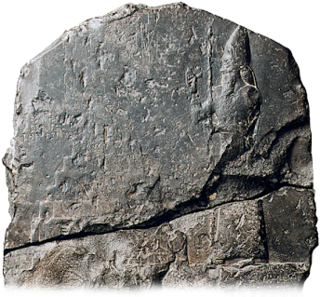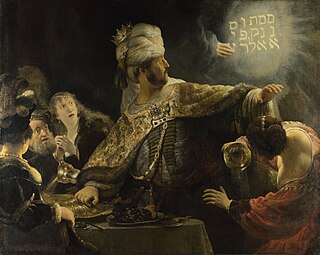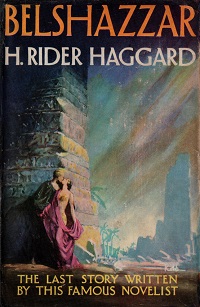See also
- Balthazar (disambiguation)
- Belshazzar's Feast (disambiguation)
- Belteshazzar, according to the Book of Daniel, was the Babylonian name given to the prophet Daniel
- Cultural depictions of Belshazzar
- Baghdasar - Armenian form of this name
Belshazzar was a Babylonian leader.
Belshazzar may also refer to:

The Book of Daniel is a 2nd-century BC biblical apocalypse with a 6th century BC setting. Ostensibly "an account of the activities and visions of Daniel, a noble Jew exiled at Babylon", it combines a prophecy of history with an eschatology both cosmic in scope and political in focus, and its message is that just as the God of Israel saves Daniel from his enemies, so he would save all Israel in their present oppression.

Nebuchadnezzar II, also spelled Nebuchadrezzar II, was the second king of the Neo-Babylonian Empire, ruling from the death of his father Nabopolassar in 605 BC to his own death in 562 BC. Historically known as Nebuchadnezzar the Great, he is typically regarded as the empire's greatest king. Nebuchadnezzar remains famous for his military campaigns in the Levant, for his construction projects in his capital, Babylon, and for the important part he played in Jewish history. Ruling for 43 years, Nebuchadnezzar was the longest-reigning king of the Chaldean dynasty. At the time of his death, Nebuchadnezzar was among the most powerful rulers in the world.

Belshazzar was the son and crown prince of Nabonidus, the last king of the Neo-Babylonian Empire. Through his mother he might have been a grandson of Nebuchadnezzar II, though this is not certain and the claims to kinship with Nebuchadnezzar may have originated from royal propaganda.

Nabonidus was the last king of the Neo-Babylonian Empire, ruling from 556 BC to the fall of Babylon to the Achaemenid Empire under Cyrus the Great in 539 BC. Nabonidus was the last native ruler of ancient Mesopotamia, the end of his reign marking the end of thousands of years of Sumero-Akkadian states, kingdoms and empires. One of the most vibrant and individualistic rulers of his time, Nabonidus is remembered as the last independent king of Babylon, and he is characterised by some scholars as an unorthodox religious reformer and as the first archaeologist.
Peres is a Portuguese, Galician, and Sephardic-Jewish surname. Its Spanish variant is Pérez.
Labashi-Marduk was the fifth and penultimate king of the Neo-Babylonian Empire, ruling in 556 BC. He was the son and successor of Neriglissar. Though classical authors such as Berossus wrote that Labashi-Marduk was just a child when he became king, Babylonian documents indicate that he had been in charge of his own affairs before his rise to the throne, suggesting he was an adult, though possibly still relatively young.

Belshazzar's feast, or the story of the writing on the wall, tells how Belshazzar holds a great feast and drinks from the vessels that had been looted in the destruction of the First Temple. A hand appears and writes on the wall. The terrified Belshazzar calls for his wise men, but they are unable to read the writing. The queen advises him to send for Daniel, renowned for his wisdom. Daniel reminds Belshazzar that his father Nebuchadnezzar, when he became arrogant, was thrown down until he learned that God has sovereignty over the kingdom of men. Belshazzar had likewise blasphemed God, and so God sent this hand. Daniel then reads the message and interprets it: God has numbered Belshazzar's days, he has been weighed and found wanting, and his kingdom will be given to the Medes and the Persians.
That very night Belshazzar, the Chaldean [Babylonian] king, was killed. And Darius the Mede received the kingdom […]
Susanna may refer to:

Darius the Mede is mentioned in the Book of Daniel as king of Babylon between Belshazzar and Cyrus the Great, but he is not known to history, and no additional king can be placed between the known figures of Belshazzar and Cyrus. Most scholars view him as a literary fiction, but some have tried to harmonise the Book of Daniel with history by identifying him with various known figures, notably Cyrus, Cyaxares, or Gobryas, the general who was first to enter Babylon when it fell to the Persians in 539 BCE.

Belshazzar's Feast is a major painting by Rembrandt now in the National Gallery, London. The painting is Rembrandt's attempt to establish himself as a painter of large, baroque history paintings. The date of the painting is unknown, but most sources give a date between 1635 and 1638.

The Chaldean dynasty, also known as the Neo-Babylonian dynasty and enumerated as Dynasty X of Babylon, was the ruling dynasty of the Neo-Babylonian Empire, ruling as kings of Babylon from the ascent of Nabopolassar in 626 BC to the fall of Babylon in 539 BC. The dynasty, as connected to Nabopolassar through descent, was deposed in 560 BC by the Aramean official Neriglissar, though he was connected to the Chaldean kings through marriage and his son and successor, Labashi-Marduk, might have reintroduced the bloodline to the throne. The final Neo-Babylonian king, Nabonidus, was genealogically unconnected to the previous kings, but might, like Neriglissar, also have been connected to the dynasty through marriage.
George Frideric Handel (1685–1759) was a German/British Baroque composer.

Belshazzar is an oratorio by George Frideric Handel. The libretto was by Charles Jennens, and Handel abridged it considerably. Jennens' libretto was based on the Biblical account of the fall of Babylon at the hands of Cyrus the Great and the subsequent freeing of the Jewish nation, as found in the Book of Daniel.

The Fall of Babylon denotes the end of the Neo-Babylonian Empire after it was conquered by the Achaemenid Empire in 539 BCE.

Nitocris of Babylon is an otherwise unknown queen regnant of Babylon described by Herodotus in his Histories. According to Histories of Herodotus, Among sovereigns of Babylon two were women, Semiramis and Nitocris. Nitocris is credited by Herodotus with various building projects in Babylon. She is also said to have tricked Darius I by placing her tomb above a gate so that no Persian could pass below and enter through. According to the account, Darius was lured in by a mysterious inscription that served as a trap for greedy kings. According to Herodotus she was the wife of Nabonidus against whose son an expedition was launched by Cyrus the Great. Dougherty and Beaulieu identify the son as Belshazzar.
Belshazzar's Feast is a story in the book of Daniel.

The "finger of God" is a phrase used in the Bible. In Exodus 8:16–20 it is used during the plagues of Egypt by the Egyptian magicians. In Exodus 31:18 and Deuteronomy 9:10 it refers to the method by which the Ten Commandments were written on tablets of stone that were brought down from Mount Sinai by Moses.

Belshazzar's Feast is an oil painting by British painter John Martin (1789–1854). It was first exhibited at the British Institution in February 1821 and won a prize of £200 for the best picture. It was so popular that it needed to be protected from the crowds by a railing, and established Martin's fame. In the words of Martin's biographer William Feaver, he "turned literary references to visual reality". Martin published mezzotint engravings in 1826 and 1832. The original painting is now held in a private collection; two smaller contemporaneous "sketches" are held by the Yale Center for British Art in New Haven, Connecticut and the Wadsworth Atheneum in Hartford, Connecticut.

Belshazzar is a historical novel by H. Rider Haggard set in Ancient Babylon. It was written in 1924, and was just finished at the time of his death.

Belshazzar, son of the last king of the Neo-Babylonian empire, Nabonidus, has inspired many works of art and cultural allusions, often with a religious motif. While a historical figure, depictions and portrayals of him are most often based on his appearance in the biblical story of Belshazzar's feast in the Book of Daniel. This story is the origin of the idiomatic expression "the writing is on the wall".